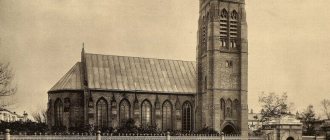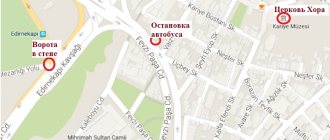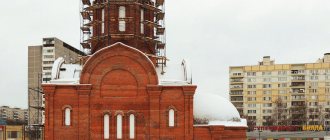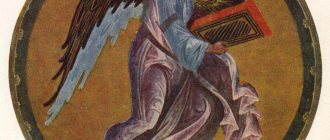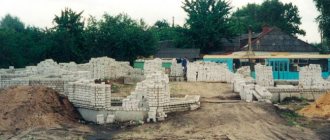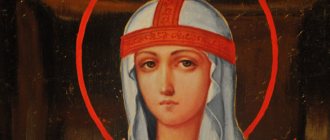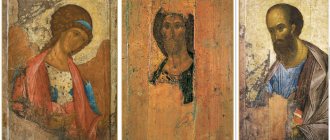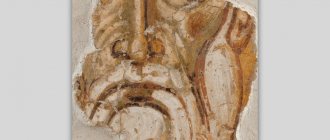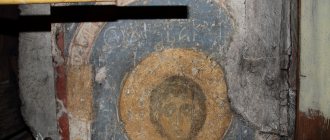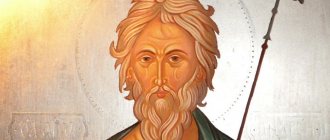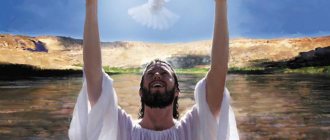The Temple of Andrei Rublev in Ramenki is the only functioning stone church in honor of the holy icon painter, who devoted his entire life to serving God. Another parish in the capital, which is currently being built in his honor, is the wooden church of St. Andrei Rublev under construction on Verkhnyaya Maslovka, vl. 1.
Very little information has been preserved about the life of the holy monk himself. It is known that even in his youth Andrei chose the monastic path for himself. His whole life was connected with the Trinity-Sergius Lavra and the Spaso-Andronikov Monastery, working and creating in which he achieved truly miraculous perfection, both creative and spiritual.
History of the temple
The idea of building the temple belongs to the church community, which registered its existence in 1993. Already in 1994, a Cross was installed on the territory of the future monastery and prayer services began to be held in honor of St. Andrew.
The parish in Ramenki is being built solely on donations from the population. The same principle is being followed in the restoration and revival of the 14th century Church of the Three Saints in Ramenki. Anyone can make a contribution as much as they can; details for donations are on the Moscow Government website in the “200 churches” section.
In 1996, next to the site of construction of the future cathedral, a wooden chapel in honor of the Intercession of the Most Holy Theotokos was built for 200 parishioners and services began.
For the next six years, until 2000, the procedure for allocating land for construction took place, design activities and engineering work were carried out.
In the period from 2000 to 2008, documentation was carried out for permission to build the church, for installation work, and funds were sought for the construction of the church complex. For this purpose, a charitable foundation was created to raise funds, which significantly accelerated the start of construction.
Construction and foundation
Finally, on October 24, 2008, the long-awaited event began - laying the first stone. On this occasion, the “First Bucket” holiday was organized. According to the individual project, the new church was supposed to accommodate up to 1000 people. By March 2009, the foundation of the future temple was made - the foundation slab.
The basis for this construction was the Transfiguration Cathedral of the Andronikov Monastery, which was painted by the holy monk Andrei Rublev himself.
- It was decided to crown the temple with one large and three small gilded domes.
- The roof should be covered with green iron sheets.
- The walls of the new church will be made of white stone.
- The construction of a belfry was envisaged.
Further fate
The design project for the top floor of the building was carried out by the creative workshop “Dabor” under the direction of D.A. Borunov, author-architect and head of the workshop. The lower (ground floor) was designed by the architect Mikhail Filippov.
The construction of the ground floor of the church was completed by November 2010. It housed:
- baptismal temple;
- Museum of St. Andrei Rublev;
- Orthodox school classes;
- office premises.
Before this event, on February 26, 2010, with the blessing of Patriarch Kirill of Moscow and All Rus', the Church was founded by His Eminence Kirill, Bishop of Pavlovo-Posad, vicar of His Holiness the Patriarch.
The construction of communications continued until 2011:
- water supply;
- sewerage;
- engineering networks;
- Interior work was carried out on the construction of the church.
The temple at present
An important stage in the construction of the parish was that, thanks to the efforts of the public, concerned citizens and parishioners themselves, in March 2021, the facility under construction was included in the “200 churches” program implemented by the Moscow Government. This event significantly accelerated the process of building the church.
On July 16, 2021, a historical event took place in the parish under construction - the raising of the domed Cross and the dome itself onto the church building. The structure weighing 16 tons was placed on the roof of the cathedral. The action was timed to coincide with the patronal feast day of St. Andrei Rublev in Ramenki.
On April 30, 2021, gilded domes and crosses, consecrated by rector Andrei Galukhin, were raised to the church belfry.
By April 2021, the main construction work was completely completed. Currently, finishing work is being completed outside and inside the church, and the walls and vaults of the parish are being painted. All work is planned to be completed by October 2021 and coincide with the 590th anniversary of the death of the great icon painter.
The great consecration of the Church of St. Andrei Rublev on Verkhnyaya Maslovka took place
On September 30, 2020, on the day of remembrance of the martyrs Vera, Nadezhda, Lyubov and their mother Sophia, the Chairman of the Financial and Economic Administration of the Moscow Patriarchate, Administrator of the Northern and Northwestern Vicariates, Bishop Paramon of Naro-Fominsk performed the rite of great consecration of the Church of St. Andrei Rublev on Verkhnyaya Maslovka and Divine Liturgy in the newly consecrated church.
Concelebrating with Vladyka Paramon were the rector of the church, Archpriest Vladimir Leonov, and the clergy of the Northern and Northwestern Vicariates.
The temple on Verkhnyaya Maslovka was erected as part of the Program for the construction of Orthodox churches in Moscow.
In his speech to the believers, the archpastor noted that thanks to this Program, Moscow, like a necklace with pearls, is decorated with new churches. Moreover, in those areas where they never existed. “New temples become not only decoration, but also a place for rest for a soul that has suffered and longs for communication with God,” said Bishop Paramon.
He conveyed to the rector and parishioners a blessing and congratulations from the ruling bishop of the Moscow diocese, His Holiness Patriarch Kirill of Moscow and All Rus'. I congratulated everyone on my own behalf. He presented awards on behalf of His Holiness Patriarch Kirill to people who worked especially hard during the construction of the temple. Thus, in recognition of the work on the construction of the Church of St. Andrei Rublev on Verkhnyaya Maslovka, Archpriest Vladimir Leonov was awarded the Order of St. Andrei Icon Painter, III degree. The Patriarchal letter in recognition of assistance in the construction of the temple was presented to L.Ya. Taiga, chairman of the parish council of the temple.
Bishop Paramon especially emphasized that faith in God is crowned not with words, but with deeds, with a grateful prayer to the Lord “for helping a person cope with the tasks facing him.”
“In Rus', it was the custom that a person tried to take for himself the little that he needed for his existence,” the bishop continued. “And I always gave all the best to God.” All the best impulses of the soul. He placed all his aspirations on God. All your hopes. And he showed his love with real deeds. Not just in words, not just in some expressions and feelings, but in deeds!”
“According to the apostle’s commandment: “Faith without works is dead.” If a person says that he believes, but does not act according to his faith, then his faith is fruitless. She is not savior. A completely different faith is one that bears fruit. The fruits of life, the fruits of good deeds. And these deeds become visible to all people. And people praise God! So, we must not only live, but also act by faith! And today you and I also acted! While consecrating the temple, we prayed together with you that the Lord would hear, support and comfort every person who crosses the threshold of this house of God,” the bishop said.
***
The idea to build a temple dedicated to the great Russian icon painter Reverend Andrei Rublev in the Town of Artists on Maslovka was born back in the 1980s, but it was destined to come to life only in the 21st century.
The Town of Artists is the first “creative commune” in Moscow, formed in the 1930s not far from Petrovsky Park and the Travel Palace. The new quarter was intended to become a place of “concentration” of the artistic elite of the city and country, a place of residence and work for masters of fine art. And so it happened. Maslovka is an amazing place. Some of the best works of painting of the Soviet period were created here, which were later included in the collection of the Tretyakov Gallery: for example, the paintings “New Moscow” (1937) by Yuri Pimenov, “Daughter of Soviet Kyrgyzstan” (1948) by Semyon Chuikov, illustrations by Evgeny Kibrik to Gogol’s “ Taras Bulba" (1944-1945) and Dementy Shmarinov to Leo Tolstoy's novel "War and Peace" (1953), paintings by Georgy Nyssa, "Spring" (1954) by Arkady Plastov, the textbook famous canvas by Fyodor Reshetnikov "Deuce Again" (1952). Projects for many famous monuments were developed here. For example, Pushkin in the Pushkin Mountains (1959), pilot V.S. Kholzunov in Stalingrad (1940). The author of these works is Ekaterina Fedorovna Belashova. Her son Alexander Mikhailovich Belashov participated in the creation of sculptures and mosaic panels for the Paleontological Museum, the Moscow Zoo, and the memorial “In Memory of the Victims of Terrorism” (next to the Theater Center on Dubrovka). The town's house book is a kind of anthology of Soviet and Russian fine art.
The dedication of the temple on Maslovka is no coincidence - artists reverence St. Andrei Rublev as their heavenly patron.
In March 2001, the painters turned to Patriarch Alexy II with a request to bless the construction of the temple. The artists were supported by local residents, and in 2003 a memorial stone was installed at the site of the future construction, and Archpriest Dimitry Smirnov performed the first prayer service. From that time on, believers began to regularly gather for prayer services to the Rev. Andrei Rublev, either in one of the workshops on Maslovka, then at the foundation stone, or in the Church of the Annunciation of the Blessed Virgin Mary in Petrovsky Park, where Archpriest Dimitry Smirnov serves. At the same time, one of the parish traditions arose - holding art markets, where paintings by famous artists and amateurs from among the parishioners are put up for sale. The proceeds are donated to the needs of the temple. An art fund has been created from paintings donated to the parish.
Despite the active parish life, the community failed to obtain a building permit for many years. And it was thanks to the Program that believers had the opportunity to find their long-awaited temple.
Work began in 2021. At the public hearing, all participants - about 300 residents of Verkhnyaya Maslovka - unanimously voted for the temple. On July 17, 2021, the first Divine Liturgy was celebrated in the basement, and in the fall, services began to be held in the church itself.
FHU press service
Share:
- Click to share on Facebook (Opens in new window)
- Share on Twitter (Opens in new window)
- Send link to Odnoklassniki (Opens in new window)
- Send link on VKontakte (Opens in new window)
- Send link to My World (Opens in new window)
- Click to share on Google+ (Opens in new window)
Architecture and decoration of the building
The architectural design and interior decoration of the church of the reverend icon painter in Ramenki is inspired by the architectural motifs of the Trinity Cathedral of St. Sergius Lavra, the Spassky Cathedral of the Andronnikov Monastery and other cross-domed single-domed churches of the 14th-15th centuries.
All floors of the parish are connected to each other by two internal staircases.
For disabled people the church provides:
- lift to the first floor of the parish;
- ramp to the basement of the building;
- toilet;
- recreation areas.
The facade of the building is lined with mosaics and painted with façade paintings. The walls are decorated with stone slabs made of natural or artificial stone, carved white stone elements are widely used. The height of the temple with the cross is 44.7 meters.
As the rector of the parish, Archpriest Andrei Galukhin, said: “A carved icon of the Holy Trinity was presented as a gift by businessman Dmitry Isaenko. The image is carved on a bog oak board. The wood is over 2000 years old!”
Sunday school at the temple
At the church of the reverend icon painter in Ramenki, the Ladybug Sunday school has existed and successfully operated for more than 10 years. The main activity of the school is the comprehensive development of the personality of children, adolescents and their parents.
“Ladybug” is visited by various categories of students:
- children from 4 years old (preschoolers);
- children from 7 years old (schoolchildren);
- teenagers from 14 years old;
- parents and parishioners.
The school tries to unite children and their parents through joint creativity based on spiritual values and Orthodox traditions.
Children and teenagers study here:
- Church Slavonic language;
- God's Law;
- creation;
- dancing;
- sing in the choir;
- study in a theater studio;
- participate in concerts and productions;
- go hiking;
- engaged in wood carving.
Sunday school students take an active part in creative competitions, Olympiads, and organize concerts for orphans, the elderly and the disabled.
Parents and church parishioners also take an active part in the work of the school:
- sing at Liturgies;
- help others;
- hold charity fairs;
- go hiking with children;
- go on pilgrimages.
Classes at the Ladybug school are held in the New building at the address: st. Ramenki, 2. Head - Ivanova Ksenia Ivanovna. When visiting school, be sure to have replacement shoes.
A temple was built in Moscow at the expense of artists
November 1, 2016
4092
Photo: Church of St. Andrei Rublev on Verkhnyaya Maslovka
A wooden church in honor of the Monk Andrei Rublev was erected on Verkhnyaya Maslovka Street in the north of the capital.
Parishioners, including many artists, held fairs where they sold their works and donated the proceeds for construction, Interfax-Religions reports.
Now the entrance groups and porch are being installed in the temple. A belfry is being built above the main entrance. Workers are installing electricity, installing floors, building stairs and a balcony for the choir.
Moscow artists expressed a desire to take part in decorating the temple after completing the interior decoration work. The construction of the temple will be fully completed by the end of the year, and then the territory will be landscaped.
In the 1930s, at this place, at the intersection of Verkhnyaya Maslovka Street and Petrovsko-Razumovskaya Alley, the “Moscow Montmartre” - the Town of Artists - was located. This is the only complex of buildings in the world specifically built for the work and life of fine art masters. Such masters as Arkady Plastov, Yuri Pimenov, Igor Grabar, Sergei Gerasimov and many others lived and worked in Gorodok. Therefore, it was decided to dedicate the temple to St. Andrei Rublev.
Artists still live and work here today. The artists' town is often confused with the artists' village on Sokol, however, unlike the one-story "village", the multi-story buildings of the "Moscow Montmartre" are one of the most striking examples of avant-garde architecture of that period. Each house is a monument to cultural history. On many buildings you can find memorial plaques dedicated to outstanding Russian artists.
In the future, the issue of building a large stone temple in this area will be considered.
Parish history
In January 2002, Patriarch of Moscow and All Rus' Alexy II blessed an initiative group of famous Russian artists - Valentin Sidorov, Andrei Gorsky, Vadim Shelov, Viktor Ivanov, Geliy Korzhev and others - for the construction of the Church of St. Andrei Rublev in the Town of Artists. The idea of building a temple on Verkhnyaya Maslovka was supported by residents of the area and leading masters of fine art. In accordance with the artistic design, the temple should lead the architectural ensemble of the Town.
In 2004, a community was registered in the name of St. Andrey Rublev. In 2005, by decree of Patriarch Alexy II, priest Vladimir Leonov was appointed rector of the temple. From this time on, on the last Sunday of every month, prayer services are held for St. Andrei Rublev.
The community has been seeking permission to build for more than ten years. Finally, by order of the Committee on Architecture and Urban Planning of the city of Moscow dated October 29, 2012, the urban planning plan of the land plot for the construction of the temple at the address was approved. Verkhnyaya Maslovka, ow. 2.
On the patronal feast day, July 17, 2021, priest Vladimir Leonov celebrated the first Divine Liturgy in the church under construction.
Program-200. Reference
The program for the construction of Orthodox churches (“Program 200”) has been deployed in all administrative districts of the capital, except for the Central. Its goal is to provide densely populated areas of the city with temples within walking distance.
The program is being implemented within the framework of an agreement between the Moscow Patriarchate and the Moscow Government.
The program is implemented entirely with donations from citizens and organizations. To raise funds, a charitable Fund was created to support the construction of churches in the city of Moscow, the co-chairs of the Board of Trustees of which are the Mayor of Moscow Sergei Sobyanin and the Patriarch of Moscow and All Rus' Kirill.
On behalf of the mayor of Moscow, the program is supervised by the mayor’s adviser, adviser on construction to the Patriarch of Moscow and All Rus', deputy of the State Duma of the Federal Assembly of the Russian Federation Vladimir Resin - he is the chairman of the fund’s working group.
Each future complex will consist of a church for 300 or 500 people and a clergy house, where a Sunday school, library, social and missionary departments and a youth work department will be located. Each temple will have ramps for the disabled and a room for mothers and children.
The original program was divided into several queues. The first stage included 61 sites selected by the Moscow Committee for Architecture, administrations and prefectures. The development of architectural solutions for temple complexes was carried out by three Moscow design institutes: State Unitary Enterprise MNIITEP, Mosproekt-2 and Mosproekt-3. The technical customer was the Office for Reconstruction and Development of Unique Objects (URiRUO) of the Department of Urban Development Policy of the City of Moscow.
In August 2010, the Moscow government issued a decree “On the construction of modular Orthodox churches on the territory of the city of Moscow,” according to which plots for construction were provided to the Church for free use.
On October 20, 2010, the Moscow government issued a decree on the selection of sites for the construction of temple complexes. As a result, Moscow authorities have already allocated about 150 plots for construction.
To date, according to information posted on the website of the Foundation for Support of the Construction of Moscow Temples, 29 churches have been built in the capital, construction and installation work has been completed on nine, and another 39 churches are under construction.
Will “Program-200” be renamed?
In September 2015, the chairman of the board of the fund “Support for the construction of churches in the city of Moscow,” Archbishop Mark of Yegoryevsk (now Metropolitan of Ryazan and Kasimov), in a commentary for TASS, stated that the fund had decided to change the official name of “Program 200.”
“The decision to move away from the number 200 was made for a number of reasons. Firstly, the number 200 is controversial: some say that it is very little, others, on the contrary, that it is a lot. Secondly, the number itself is soulless. The program should have a symbolic name - the idea and the goal should come first,” said Archbishop Mark.
And even earlier, in April 2015, the issue of renaming was raised by Patriarch Kirill at a regular meeting of the board of trustees of the fund “Support and construction of churches in the city of Moscow.”
“The number of temple complexes that are supposed to be built is increasing by one and a half times. And, accordingly, the name of our program “200 temples” becomes very arbitrary. Maybe we should invite Muscovites to think about what our program could be called without using any numbers,” the patriarch suggested, addressing the mayor of the capital Sergei Sobyanin.
A few months later, in August 2015, the curator of “Program-200” Vladimir Resin announced that due to plans for the construction of new churches on the territory of New Moscow, the number of objects will increase to 380.
Archbishop Mark noted in September 2015 that for the sake of broader discussion, it was decided to hold a vote to select a new name for the program on the Active Citizen portal. However, to date such a vote has not yet been organized.
How are the services held?
The parish is open daily from 7.00 to 19.00.
In the Church of Andrei Rublev in Ramenki, the following shrines are especially revered:
- The icon of the Hieromartyr Thaddeus, Archbishop of Tver, with a particle of relics, whose feast day is December 31 according to the new style, is celebrated in the church with a solemn polyeleos matins, and after the Divine Liturgy - with a festive prayer service in honor of this saint.
- Icon of St. Andrei Rublev, icon painter of the Trinity, who is the heavenly patron of the Temple in Ramenki.
- Icon of the Intercession of the Mother of God.
During the construction of the parish, there is a temporary wooden chapel of the Intercession of the Blessed Virgin Mary.
Schedule of services by day of the week:
- on weekdays, morning services begin at 8.00;
- on Friday Liturgy at 8.00, Vespers and Akathist to Sergius of Radonezh at 18.00;
- on Saturday Liturgy at 8.00, prayer service in favor of the construction of the church at 16.00, All-night vigil held in the church under construction from 17.00;
- on Sunday Liturgy at 7.00, late Liturgy in the church under construction at 10.00, vespers at 17.00 with Akathist to the Intercession of the Mother of God.
An additional schedule signed by the rector, Archpriest Andrei Galukhin, is drawn up for each month and is available on the official website of the parish.
Today the parish employs:
- temperance society;
- charity group;
- youth organization;
- Sunday School.
Russian Orthodox ChurchFinancial and economic management
On September 30, the Chairman of the Financial and Economic Administration of the Russian Orthodox Church, Bishop Paramon of Naro-Fominsk, in front of a large crowd of people, performed the rite of consecration of the new church of St. Andrei Rublev on Verkhnyaya Maslovka Street in Moscow.
Concelebrating with Vladyka Paramon were the rector of the church, Archpriest Vladimir Leonov, and the clergy of the Northern and Northwestern Vicariates.
The temple on Verkhnyaya Maslovka was erected as part of the Program for the construction of Orthodox churches in Moscow.
In his speech to the people, the archpastor noted that thanks to this Program, Moscow, like a necklace with pearls, is decorated with new churches. Moreover, in those areas where they never existed. “New temples become not only decoration, but also a place for rest for a soul that has suffered and longs for communication with God,” said Bishop Paramon.
He conveyed to the rector and parishioners a blessing and congratulations from the ruling bishop of the Moscow diocese, His Holiness Patriarch Kirill of Moscow and All Rus'. I congratulated everyone on my own behalf. He presented awards on behalf of His Holiness Patriarch Kirill to people who worked especially hard during the construction of the temple. Thus, in consideration of the work on the construction of the Church of St. Andrei Rublev on Upper Maslovka in Moscow, Archpriest Vladimir Leonov, the rector of the temple, was awarded the Order of the Russian Orthodox Church of St. Andrew, Icon Painter, III degree.
The Patriarchal letter in recognition of assistance in the construction of the temple was presented to Taiga Lydia Yakovlevna, the chairman of the parish council of the temple.
Bishop Paramon especially emphasized that faith in God is crowned not with words, but with deeds, with a grateful prayer to the Lord “for helping a person cope with the tasks facing him.”
“In Rus', it was the custom that a person tried to take for himself the little that he needed for his existence,” the bishop continued. “And I always gave all the best to God.” All the best impulses of the soul. He placed all his aspirations on God. All your hopes. And he showed his love with real deeds. Not just in words, not just in some expressions and feelings, but in deeds !”
“According to the apostle’s commandment: “ Faith without works is dead .” If a person says that he believes, but does not act according to his faith, then his faith is fruitless. She is not savior. A completely different faith is one that bears fruit. The fruits of life. The fruits of good deeds. And these deeds become visible to all people. And people praise God! So, we must not only live, but also act by faith! And today you and I also acted! While consecrating the temple, we prayed together with you that the Lord would hear, support and comfort every person who crosses the threshold of this house of God.”
AllVerkhnyaya Maslovka, consecration, 09.30.2020
The idea to build a temple dedicated to the great Russian icon painter Reverend Andrei Rublev in the Town of Artists on Maslovka was born back in the 1980s, but it was destined to come to life only in the 21st century.
The Town of Artists is the first “creative commune” in Moscow, formed in the 1930s not far from Petrovsky Park and the Travel Palace. The new quarter was intended to become a place of “concentration” of the artistic elite of the city and country, a place of residence and work for masters of fine art. And so it happened. Maslovka is an amazing place. Some of the best works of painting of the Soviet period were created here, which were later included in the collection of the Tretyakov Gallery: for example, the paintings “New Moscow” (1937) by Yuri Pimenov, “Daughter of Soviet Kyrgyzstan” (1948) by Semyon Chuikov, illustrations by Evgeny Kibrik to Gogol’s “ Taras Bulba" (1944–1945) and Dementy Shmarinov to Leo Tolstoy's novel "War and Peace" (1953), paintings by Georgy Nyssa, "Spring" (1954) by Arkady Plastov, the textbook famous canvas by Fyodor Reshetnikov "Deuce Again" (1952). Projects for many famous monuments were developed here. For example, Pushkin in the Pushkin Mountains (1959), pilot V.S. Kholzunov in Stalingrad (1940). The author of these works is Ekaterina Fedorovna Belashova. Her son Alexander Mikhailovich Belashov participated in the creation of sculptures and mosaic panels for the Paleontological Museum, the Moscow Zoo, and the memorial “In Memory of the Victims of Terrorism” (next to the Theater Center on Dubrovka). The town's house book is a kind of anthology of Soviet and Russian fine art.
The dedication of the temple on Maslovka is no coincidence - artists reverence St. Andrei Rublev as their heavenly patron.
In March 2001, the painters turned to Patriarch Alexy II with a request to bless the construction of the temple. The artists were supported by local residents, and in 2003 a memorial stone was installed at the site of the future construction, and Archpriest Dimitry Smirnov performed the first prayer service. From that time on, believers began to regularly gather for prayer services to the Rev. Andrei Rublev, either in one of the workshops on Maslovka, then at the foundation stone, or in the Church of the Annunciation of the Blessed Virgin Mary in Petrovsky Park, where Archpriest Dimitry Smirnov serves. At the same time, one of the parish traditions arose - holding art markets, where paintings by famous artists and amateurs from among the parishioners are put up for sale. The proceeds are donated to the needs of the temple. An art fund has been created from paintings donated to the parish.
Despite the active parish life, the community failed to obtain a building permit for many years. And it was thanks to the Program that believers had the opportunity to find their long-awaited temple.
Work began in 2021. At the public hearing, all participants - about 300 residents of Verkhnyaya Maslovka - unanimously voted for the temple. On July 17, 2021, the first Divine Liturgy was celebrated in the basement, and in the fall, services began to be held in the church itself.
